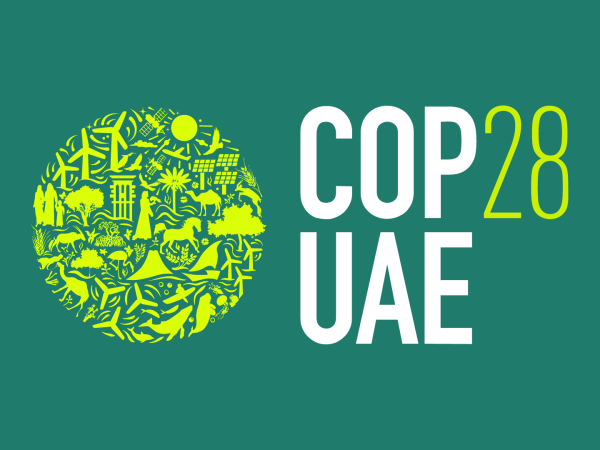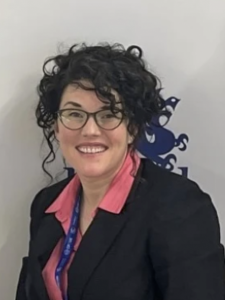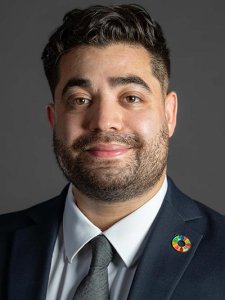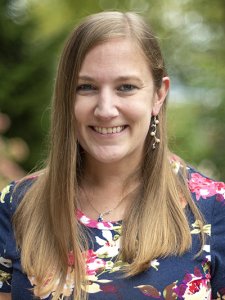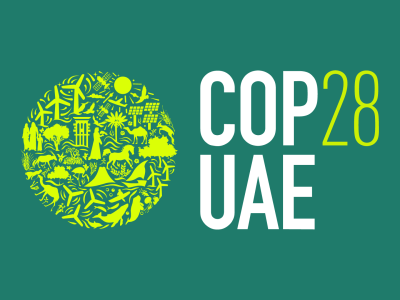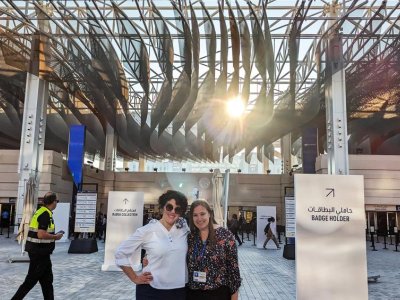A six-person Penn State delegation traveled to Dubai for the United Nations Framework Convention on Climate Change's COP28. A month after the event, the delegation—Olivia McMahon, Esther Obonyo, Mark Ortiz, Brandi Robinson, Vikrant Sapkota, and Erica Smithwick—reflects on COP28, what was important, and what the future may bring.
- What did you learn from going to COP28?
- What were the most important discussions/topics at COP28?
- What do you look forward to seeing/hearing more about in the climate space after COP28?
- How did/will this experience shape your future work?
What did you learn from going to COP28?
Olivia McMahon
Any gathering of representatives from such a wide array of places is bound to bring with it competing interests. There was a definite recognition among all attendees that addressing climate change and ensuring a just transition away from fossil fuels will not be easy. However, I was struck by the pervasive feeling of positivity at the heart of the conference. Contrary to what I have seen portrayed in the media, the COP experience is not limited to parties pushing forward their agendas. It is a collection of thousands of committed individuals working across sectors in a spirit of collaboration. COP28 was a hive of ideas attended by people seeking opportunities to increase understanding and create real-world solutions.
Esther Obonyo
From a built environment perspective, there is much more work to be done. There have also been some encouraging developments championed by the Global Alliance for Building and Construction, an initiative that was launched by UNEP and the government of France. For three years in a row, there is a dedicated buildings pavilion at the Climate Summit featuring stakeholders from various governments, private sector companies, academia, and other non-profit organizations that are all committed to working collaboratively to translate the recommendations of various roadmaps into action at the grassroots level.
Mark Ortiz
I learned more about how climate change intersects with other social, economic, and cultural forces and how our climate solutions must encompass all of these domains. From efforts to engage young people in redefining sustainable agriculture highlighted by a World Food Forum panel I attended, to the range of different musical responses to climate change I heard at the Entertainment + Culture and Climate Live Pavilions, to fascinating conversations about how to plug young people into green jobs and follow youth leadership in peace-building efforts, this was a COP where climate solutions were defined broadly and intersectionally. As we at Penn State scale up our work in the climate solutions space, I’m bringing back this intersectional emphasis from COP 28.
Brandi Robinson
COP is so much more than the high-level climate negotiations we most often think of or read about. And while those negotiations are of course critically important for advancing our global progress toward addressing the climate crisis (and really powerful to observe in person!), for me, the ultimate power and momentum of COP28 was witnessing 80,000+ people from around the world come together to share their efforts, build partnerships, and learn from others. So many people are doing so much incredible work – it’s hard not to feel encouraged and inspired and maybe even hopeful about the climate legacy we’re forging.
Vikrant Sapkota
Attending COP28 was extremely insightful. The biggest takeaway? The sheer complexity of climate negotiations. It's not just about data; it's about balancing diverse global interests. For instance, the debate over the Loss and Damage fund really stood out. It wasn't just about money; it was a deeper conversation about responsibility and fairness. And then, there's technology – like how space data can track deforestation in real time. Conversing with experts from various fields, I realized how crucial interdisciplinary approaches are in tackling climate issues. This experience has not only broadened my horizons but also fueled my passion for diving deeper into climate science and policy.
Erica Smithwick
Global political negotiations will not solve the climate crisis. They are critical, but the problem is too hard — and too far advanced — to be solved by the political process alone. Rather, this is an all-of-society issue, and it was motivating to be at a COP where all these sectors were in discussions with each other: industry, Indigenous communities, philanthropy, academia, non-governmental organizations, civil society, and politicians. I was excited to see these cross-sector partnerships in action on the global stage, and motivated to identify these opportunities for climate action at Penn State.
What were the most important discussions/topics at COP28?
Olivia McMahon
As it stands, international and national commitments will not be enough to keep the planet below the 1.5˚C warming threshold. This does not preclude us from setting more ambitious goals at the subnational level. One theme that was woven throughout the myriad of topics discussed at COP28 was the importance of local-level actions. There were many examples of local governments, businesses, community groups and educational institutions carrying out effective climate initiatives. These actions often create the environment for broader initiatives to be developed while simultaneously addressing community-specific challenges.
Esther Obonyo
The role of higher education institutions in helping generate evidence on cost-effective, equitable, and just climate solutions was a common theme in all the sessions. For the building sector, cement and steel have been identified as the top contributors to greenhouse gas emissions. It was encouraging to see leading manufacturers and users of these building materials come together to explore ways of addressing these emissions and their impacts through, for example, investments in R&D on alternative materials, making the production processes more efficient and capturing emissions that are already there.
Mark Ortiz
COP28 was full of splashy announcements, and as a conference that brought together over 80,000 participants, it can be difficult to sift through the final outcomes and separate signal from noise. Of course, Loss and Damage was a significant focus area in the political negotiations and while much remains to be figured out in the implementation phase of the fund the significance of the agreement on Loss and Damage cannot be overstated. A less discussed outcome of COP28, but one that I find especially important, was the COP28 Declaration on Climate, Relief, Recovery, and Peace. The relationship between climate and conflict has not been fully taken up in the COP process until this year, and the Declaration very clearly highlights the disproportionate impacts of climate change on conflict-affected communities and indicates the need for integrated action which addresses the intersections of climate resilience, conflict reduction, and peace-building. There was significant youth activism for peace at the COP this year, too, which I think illustrates that greater attention is being paid to the critical co-benefits of building climate adaptivity and the infrastructure for sustainable peace.
Brandi Robinson
At COP28, the focus on the first Global Stocktake was really a key theme. The Global Stocktake is the mechanism built into the Paris Agreement for assessment every five years of our global progress on all fronts – reducing emissions, adapting to impacts, and ensuring we have the financial means to do it all. Deeply rooted in this assessment are critical questions related to equity and justice in a transition to a low-carbon future. The question of phasing out fossil fuels weighed heavily on this COP, and ultimately, the resulting agreement produced the strongest language on this front in COP history. Was it strong enough to satisfy all parties? No. But it still marks an important explicit recognition of the need to move away from our business-as-usual practices of reliance on unabated fossil fuels.
Vikrant Sapkota
At COP28, several discussions stood out as particularly relevant to me as a climate science graduate student. The evolving role of academia in addressing health impacts related to climate change was a key focus, highlighting the increasing intersection of science and public policy. The engagement of the private sector was more pronounced than ever, reflecting a shift towards diverse stakeholder involvement in climate discussions. This included debates on how businesses can align with sustainability goals and the importance of integrating sustainability into core business practices. These discussions were complemented by high-level talks on global stocktake, the establishment of the Loss and Damage fund, technologies to tackle emissions, boosting clean energy capacity, and financing for the costs of climate change, marking COP28's comprehensive and multi-dimensional approach to tackling climate change.
Erica Smithwick
One of the most exciting parts of the meeting happened on the very first opening session, in which the parties agreed to the formation of a Loss and Damage Fund to support countries already facing the unavoidable impacts of climate change. This was the focus of COP27 in Egypt, and there was a sense, going into Dubai, that this issue would dominate the meetings. Instead, the draft text was adopted on the first day – something that has never happened before. There are still questions about the fund itself (Will financial commitments be sufficient? Will civil society be represented on the board that makes funding decisions? How will the funds reach nations and communities most in need without adding to debt and loan burdens?), but the fact that major nations (including the U.S.) provided financial commitments right from the start engendered a sense of action that permeated the rest of the meeting.
What do you look forward to seeing/hearing more about in the climate space after COP28?
Olivia McMahon
I am interested in learning more about (and hopefully seeing more) work on the part of the international community to provide financing to support local efforts to adapt to current conditions and work toward mitigation of climate change. I hope to see a financial commitment to the Loss and Damage Fund increase and nations rally to provide local authorities with the tools they need to tailor climate action to the needs of their communities. Our collective goals will not be met without subnational participation.
Esther Obonyo
One of the outcomes of COP28 was the Buildings Breakthrough. I am looking forward to seeing how the participating countries translate this agreement into policies and regulations that help decarbonize the building sector in a just and inclusive manner.
Mark Ortiz
I think there is a range of exciting and important work happening to develop collaborative projects with children (under 18) to highlight their perspectives and experiences of climate change as well as criteria for climate solutions that ensure that they are inclusive of the needs of children and youth. In my previous experiences at COPs, the conversation about children’s rights and the centrality of children’s voices was not as pronounced as at COP28, and I’m eager to see more participation of children in the process and platforming of their solutions at future COPs.
Brandi Robinson
Action. COPs are very good at delivering promises, but can those promises deliver the necessary action? I’m watching closely to see how these promises materialize into quantifiable reductions, meaningful financing, and effective resilience building. While COP28 gave us much to be very hopeful about, the science is still staggeringly sober – swift and steep actions are needed to avert warming more than 1.5˚C.
Vikrant Sapkota
Post-COP28, I'm especially keen on the advancements of Climate TRACE, an initiative co-founded by Al Gore and publicly launched at the conference. This groundbreaking tool employs over 300 satellites, along with land, air, and sea sensors, integrated through artificial intelligence to accurately track global greenhouse gas emissions. Its methodology, focusing on analyzing multiple data streams like smoke plumes and infrared heat signatures, offers a precise and comprehensive view of emissions from significant sources worldwide. The potential of Climate TRACE to revolutionize emissions tracking and hold countries accountable is immense, and I'm eager to see its impact on shaping future climate policies and actions.
Erica Smithwick
While the Loss and Damage Fund is a big "win" for COP28, it is also a clear signal that climate impacts are already here. Yet, such funds would not be needed if communities were adequately financed to adapt to climate change in the first place. Unfortunately, the 2023 Adaptation Gap Report concludes that the adaptation finance gap is US$194 to US$366 billion per year. Existing commitments to existing climate finance for adaptation, if actualized, would only close that gap by 5 to 10%. I’ll be watching to see if countries step up their commitments to adaptation finance and/or how other sectors such as philanthropy or local climate action planning fill the gap. Otherwise, that Loss and Damage Fund becomes even more important.
How did/will this experience shape your future work?
Olivia McMahon
After attending COP28, I will move forward with a new sense of optimism. I think that one of the biggest challenges we face (myself included) is in recognizing that our actions as individuals matter. As a participant in the Penn State Local Climate Action Program, I saw first-hand the positive and tangible impacts that local-level initiatives can provide for a community. At COP, I developed a deeper understanding of the global ramifications of local programs. I hope to carry the spirit of commitment, ingenuity, and collaboration that I witnessed at COP28 with me in my future endeavors.
Esther Obonyo
As a direct outcome of my participation in COP28, I will be contributing to the development of a strategy for expanding the contributions of higher education-led networks to the work of the Global Alliance for Building and Construction. The needs are aligned with the interdisciplinary research and education priorities of the Penn State-led Global Building Network.
Mark Ortiz
This conference strengthened my existing commitment to elevating the perspectives of children and young people in the international climate policy conversation. I made wonderful connections at COP28 and discussed some exciting project possibilities with youth storytellers, researchers, and content creators around the world. COP28 also made me realize how significant a gap exists in researchers’ efforts to communicate their climate science findings in formats accessible to children and young people who do not speak or read English, an area that I think will be important to the collaborative partnerships between my Lab and youth content creators in the future.
Brandi Robinson
My work has always focused on mitigation (and increasingly adaptation) at the local scale here in the US. My experience at COP28 strongly reaffirmed the important role local climate action plays in tackling the global problem. As I think ahead to the future of my work, I’m thinking about ways to amplify local climate action across Pennsylvania and the US, building capacity in our communities while providing students with experiential learning opportunities. Universities have a unique opportunity to support our local communities as they seek to reduce emissions and build resilience to current and anticipated impacts. What can we learn from people all around the world who are also working to reduce emissions in their communities while building more resilient, equitable, thriving places to call home.
Vikrant Sapkota
The COP28 experience has significantly influenced my approach to climate research, underscoring the need for clear communication and the integration of academic and industry research. I gained an insider's view of climate negotiations and the critical role scientific research plays in policymaking. This highlighted the necessity of effectively conveying complex scientific data to policymakers, an area I intend to emphasize in my future work. Additionally, I observed the distinct contributions of the private sector in climate action, markedly different from academia. Recognizing the importance of making academic research applicable in private markets, I am motivated to explore how these two spheres can intersect more effectively. Moving forward, my aim is to meld these insights into my work, striving to bridge the gaps between research, policy, and industry for impactful and comprehensive climate research.
Erica Smithwick
Penn State’s new Climate Consortium presents an opportunity for us to support the partnerships called for at COP28 – innovating solutions that address issues around health, gender, youth, Indigenous and local communities, energy transition and beyond. To do so requires that we work together across disciplines and with society in ways that we haven’t dared before. Our world is changing before our eyes, sometimes in ways that are scary and alarming. However, every large-scale societal transition has come with opportunities for reorganization and regeneration. We have an opportunity to catalyze changes that lead to the better of people and the planet, and I am even more motivated to be part of those solutions.

